
John Cresswell Parkin was a Canadian architect. From 1947 to 1969 he was the design chief for the Toronto firm John B. Parkin Associates with partner John B. Parkin. At the time it was the largest architectural firm in the Canada. In 1970 he formed his own firm, where he worked until his retirement in 1987. He is credited as one of the leaders in developing the mid-century modern style in Canada.

The Bishop Strachan School is an Anglican day and boarding school for girls in Toronto, Ontario, Canada. The school has approximately 900 students, including 80 boarding students, ranging from Junior Kindergarten to Grade 12. The School is named after John Strachan, the first Anglican bishop of Toronto, and was founded by John Langtry in 1867. The founders' intention was to educate girls to be leaders.
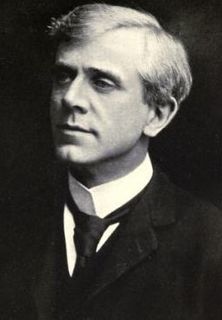
John Andrew Pearson was an early 20th-century British-born Canadian architect and partner to the Toronto-based firm of Darling and Pearson.
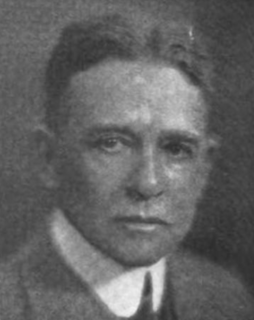
Henry Sproatt was a Canadian architect who was prominent during the early 20th century. Born in Toronto, he trained in Europe and in New York City.

Frank Darling was an important Canadian architect, winner of the RIBA Gold medal in 1915, who designed many of Toronto's landmark institutional and financial buildings, as well as scores of bank branches throughout the country. Darling is best described as an 'Edwardian imperialist' in his outlook and architectural approach, and accordingly left a legacy of fine Edwardian Baroque buildings in Canada's major cities, representative of the period's prosperity and optimism.
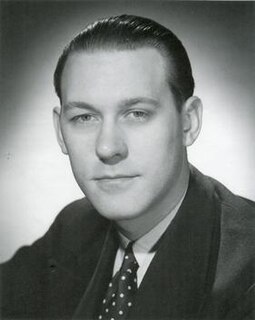
Peter Allgood Rastall Dickinson was a British-Canadian architect. Practising from the late 1940s to the early 1960s and working primarily in Toronto, Dickinson is credited as one of the leaders in developing the Mid-Century Modern style in Canada during the post-World War II period.
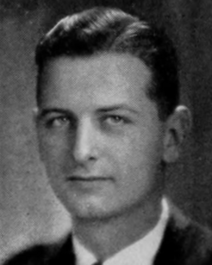
John Burnett Parkin was a Canadian architect. Parkin is best known as the principal of the firm John B. Parkin Associates, which he operated from 1947 to 1968 with partner John C. Parkin, and which produced the largest body of mid-century modern architecture in Canada.
Darling and Pearson was an architectural firm based in Toronto from 1895 through 1937. The firm was prolific and produced consistently fine work though the patronage of notable figures of the Canadian establishment, and is responsible for enhancing the architectural character and quality of the city, and indeed the rest of Canada, in the first quarter of the 20th century.

The North York Civic Centre is a municipal government building in Toronto, Ontario, Canada. It opened in 1979 as the city hall of the former city of North York. It is located in North York City Centre.
Ross and Macdonald was one of Canada's most notable architecture firms in the early 20th century. Based in Montreal, Quebec, the firm originally operated as a partnership between George Allen Ross and David MacFarlane from 1907 to 1912. MacFarlane withdrew from the firm in 1912, and Robert Henry Macdonald became a partner.

Built in 1931 and formerly known as the Canada Permanent Trust Building in Toronto, 320 Bay Street designed by the architect Henry Sproatt. It is an 18-storey office building located in the heart of downtown Toronto.

Gordon Davies Giffin became the 34th United States Ambassador to Canada on September 17, 1997.

Keiller MacKay Collegiate Institute is a medium-sized public high school building located in Toronto's west end close to the intersection of Islington Avenue and Highway 401. Opened in 1971 until closing in 1983, it was overseen by the Etobicoke Board of Education, which was joined with other school boards in the Toronto area during the city's amalgamation to form what is now the Toronto District School Board.
Samuel George Curry was a Canadian architect who practiced in Toronto as the junior partner of several of Toronto’s leading architects, among them Frank Darling and from 1892 Darling's partner John A. Pearson, Henry Sproatt, Francis S. Baker, Ernest Rolph and W. F. Sparling.
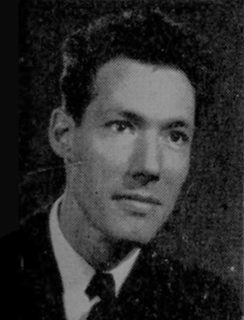
James William Strutt was a Canadian architect. Practising between 1950 and 1999 and working primarily in the Ottawa area, Strutt is noted for his role in the development of modern architecture in Canada following World War II.
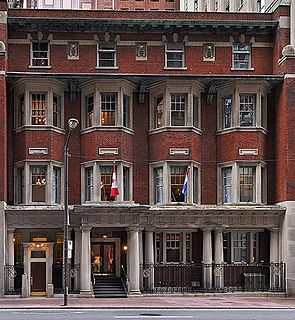
The National Club is a private club founded in 1874 for business professionals located in the Financial District of Downtown Toronto, Ontario, Canada. It provides private dining and meeting facilities and accommodations to its members and guests.

Frederick Barnard Fetherstonhaugh was a Canadian patent lawyer and agent who founded the patent agency Fetherstonhaugh & Co. He was widely recognized for his expertise in patent law. Fetherstonhaugh was also the owner of one of the first electric cars in Canada.
Gordon Lee Atkins is a Canadian retired architect. During a career lasting from 1960 to 1999, he practiced primarily in Calgary, although he designed several projects elsewhere in western Canada. Along with contemporaries including Peter Hemingway, Jack Long, and Douglas Cardinal, Atkins is credited with developing a distinct Canadian prairie style of architecture. In 1967 Atkins became the first Albertan to receive the Massey Medal for Architecture.
Adamson Associates is a Toronto-based architectural firm founded in 1934.
Carter, Coleman and Rankin Associates was a Toronto-based architectural firm responsible for building several high schools for the then Scarborough Board of Education in the 1950s. The firms' work on these schools were influenced by International Style during the post War period.














